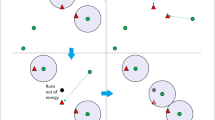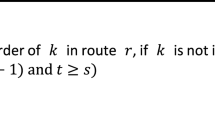Abstract
This paper proposes a seamless mobility handover scheme (SMH) for IPv6 over low power wireless personal area networks wireless sensor networks. In SMH, the routing of the control messages for the mobility handover is performed in the link layer and is automatically achieved through the IPv6-access-node trees, so the mobility handover cost is reduced and the delay is shortened. SMH proposes the hierarchical IPv6 address structure for sensor nodes which effectively shortens the length of an IPv6 address and reduces the transmission cost. In SMH, a mobile sensor node does not need a care-of address during the mobility handover process, so it does not need to perform the binding operation between its home address and care-of address. As a result, the mobility handover cost is reduced and the delay is shortened. The paper analyzes the performance parameters of SMH, and the data results show that SMH reduces the mobility handover cost and shortens the delay.












Similar content being viewed by others
References
Kushalnagar, N., Montenegro, G., & Schumacher, C. (2007). 6LoWPAN: Overview, assumptions, problem statement, and goals. IETF RFC, 4919, August 2007.
Shin, M., Camilo, T., Silva, J., & Kaspar, D. (2007). Internet-Draft-6lowpan-mobility, Internet-Draft, November 2007.
Johnson, D. B., Perkins, C. E., & Arkko, J. (2004). Mobility support in IPv6. IETF RFC, 3775.
Soliman, H., Castelluccia, C., Malki, K., & Bellier, L. (2005). Hierarchical MIPv6 mobility management, RFC, 4140, August 2005.
Hui, J., Culler, D., & Chakrabarti, S. (2009). 6LoWPAN: Incorporating IEEE 802.15.4 into the IP architecture. IPSO Alliance White Paper #3, January 2009.
Akyildiz, I., Xie, J., & Mohanty, S. (2004). A survey of mobility management in next-generation all-IP based wireless systems. IEEE Wireless Communications, 11, 16–28.
Saha, D., Mukherjee, A., Misra, I., & Chakraborty, M. (2004). Mobility support in IP: A survey of related protocols. IEEE Network, 18, 34–40.
Ramjee, R., La Porta, T., Thuel, S., Varadhan, K., & Wang, S. (1999) HAWAII: A domain based approach for supporting mobility in wide area wireless area networks. In Seventh international conference on network protocols, Toronto, Canada (pp. 283–292).
Kim, H., & hong, C. (2007). A routing scheme for supporting network mobility of sensor network based on 6LoWPAN. In Asia-Pacific network operations and management symposium 2007 (pp. 155–164). Berlin: Springer Press.
Kim, H., hong, C., & Shon, T. (2008). A lightweight NEMO protocol to support 6LoWPAN. ETRI Journal, 30(5), 685–695.
Devarapalli, V., et al. (2005). Network mobility(NEMO) basic support protocol. IETF RFC, 3963.
Gundavevelli, S., Leung, K., Devrapalli, V., Chowdhury, K., & Patil, B. (2008). Proxy mobile IPv6, IETF RFC5215, August 2008.
Shin, M. K., & Kim, H. J. (2009). L3 mobility support in large-scale IP-based sensor networks (6LoWPAN). In 11th International conference on advanced communication technology, 2009 (pp. 941–945). New York: IEEE Press.
Bag, G., Shams, S. M. S., Akbar, A. H., Raza, H. M. M. T., Kim, K. H., & Yoo, S. W. (2009). Network assisted mobility support for 6LoWPAN. In 6th IEEE consumer communications and networking conference, Las Vegas, USA, 10–13 January 2009 (pp. 1–5).
Bag, G., Raza, M., Kim, K., & Yoo, S. (2009). LoWMob: Intra-PAN mobility support schemes for 6LoWPAN. Sensors, 9, 5844–5877.
Mettali, G. S., Elabidi, A., & Farouk, K. (2010). Distributed address auto configuration protocol for Manet networks. Telecommunication Systems, 44, 39–48.
Ha, M., Kim, D., Kim, S. H., & Hong, S. (2010). Inter-MARIO: A fast and seamless mobility protocol to support inter-PAN handover in 6LoWPAN. In IEEE communications Society subject matter experts for publication in the IEEE Globecom 2010 proceedings (pp. 1–6). New York: IEEE Press.
Wang, X. N., & Zhong, S. (2011). An IPv6 address configuration scheme for wireless sensor networks based on location information. Telecommunication Systems. doi:10.1007/s11235-011-9499-z.
Liao, W. H., Tseng, Y. C., & Sheu, J. P. (2001). GRID: A fully location-aware routing protocol for mobile ad hoc networks. Telecommunication Systems, 18(1–3), 37–60.
Chiu, K.-L., & Hwang, R.-H. (2012). Communication framework for vehicle ad hoc network on freeways. Telecommunication Systems, 50, 243–256. doi:10.1007/s11235-010-9401-4.
Yan, F., Dridi, M., & El-Moudni, A. (2012). New vehicle sequencing algorithms with vehicular infrastructure integration for an isolated intersection. Telecommunication Systems, 50, 325–337. doi:10.1007/s11235-010-9407-y.
Gu, L. & Stankovic, J. A. (2005). Radio-triggered wake-up for wireless sensor networks. In 10th IEEE real-time and embedded technology and applications symposium, Miami, USA, March 2005 (pp. 157–182).
Yu, W., Chang, C.-C., & Chou, J.-H. (2010). Minimizing the number of clusters in IEEE 802.15.4 wireless sensor networks. http://people.chu.edu.tw/~cwyu/PaperPublished/cluster.pdf.
Cuomo, F., Della Luna, S., & Cipollone, E. (2008). Topology formation in IEEE 802.15.4: Cluster-tree characterization. In Sixth annual IEEE international conference on pervasive computing and communications, 2008 (pp. 276–281). New York: IEEE press.
Hoai-Nam, N., & Youichi, S. (2009). A node’s number of neighbors in wireless mobile ad hoc networks: A statistical view. In Eighth international conference on networks (pp. 52–60).
IEEE Computer Society. (2007). Part 15.4: Wireless medium access control (MAC) and physical layer (PHY) specifications for low-rate wireless personal area networks (WPANs), IEEE Standard 802.15.4. August 2007.
Shelby, Z., Chakrabarti, S., Nordmark, E., & Bormann, C. (2012). Neighbor discovery optimization for IPv6 over low-power wireless personal area networks (6LoWPANs). IETF RFC, 6775.
Narten, T., Nordmark, E., Simpson, W., & Soliman, H. Neighbor discovery for IP version 6 (IPv6). IETF, RFC 4861.
Mao, G., Fidanb, B., & Andersonb, B. D. O. (2007). Wireless sensor network localization techniques. Computer Networks, 51(10), 2529–2553.
Zhang, L., Cheng, Q., Wang, Y., & Zeadally, S. (2008). A novel distributed sensor positioning system using the dual of target tracking. IEEE Transactions on Computers, 57, 246–260.
Ssu, K.-F., Ou, C.-H., & Jiau, H. C. (2005). Localization with mobile anchor points in wireless sensor networks. IEEE Transactions on Vehicular Technology, 54(3), 1187–1197.
Chang, R., & Chuang, C.-C. (2012). A new spatial IP assignment method for IP-based wireless sensor networks. Personal and Ubiquitous Computing, 16, 913–928.
Montenegro, G., Kushalnagar, N., & Hui, J. (2007). Transmission of IPv6 packets over IEEE802.15.4 networks. IETF RFC 4944, September 2007.
Camp, T., Boleng, J., & Davies, V. (2002). A survey of mobility models for ad hoc network research. Wireless Communications and Mobile Computing (WCMC), 2(5), 483–502.
Kyildiz, I. F., Su, W., Sankarasubramaniam, Y., et al. (2002). Wireless sensor networks: A survey. Computer Networks, 38(4), 393–422.
Kwon, T. T., Gerla, M., Das, S., & Das, S. (2002). Mobility management for VoIP service: Mobile IP vs SIP. IEEE Wireless Communications, 9(2), 66–75.
Lo, S. C., Lee, G., Chen, W. T., & Liu, J. C. (2004). Architecture for mobility and QoS support in All-IP wireless networks. IEEE Journal on Selected Areas in Communications, 22(4), 691–705.
Kimura, N., & Latifi, S. (2005). A survey on data compression in wireless sensor networks. In Proceedings of the international conference on information technology: Coding and computing (ITCC’05) (Vol. 02, pp. 8–13).
Cao, Q., Abdelzaher, T., & He, T., et al. (2005). Towards optimal sleep scheduling in sensor networks for rare-event detection. In Proceedings of the 4th international symposium on information processing in sensor networks (p. 4). IEEE Press.
Lu, G., Sadagopan, N., & Krishnamachari, B., et al. (2005). Delay efficient sleep scheduling in wireless sensor networks. In INFOCOM. 24th annual joint conference of the IEEE computer and communications societies. Proceedings IEEE (Vol. 4, pp. 2470–2481). IEEE.
Koodli, R., Ed. (2008). Mobile IPv6 fast handovers. RFC 5268.
Acknowledgments
This work is supported by National Natural Science Foundation of China (61202440).
Author information
Authors and Affiliations
Corresponding author
Rights and permissions
About this article
Cite this article
Xiaonan, W., Hongbin, C. Research on seamless mobility handover for 6LoWPAN wireless sensor networks. Telecommun Syst 61, 141–157 (2016). https://doi.org/10.1007/s11235-015-0042-5
Published:
Issue Date:
DOI: https://doi.org/10.1007/s11235-015-0042-5




